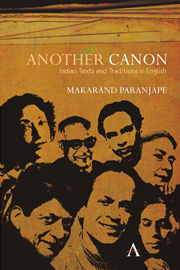Book contents
- Frontmatter
- Contents
- Preface
- 1 Introduction
- 2 Conversations in Bloomsbury
- 3 Comrade Kirillov
- 4 ‘A Horse and Two Goats’
- 5 The Tale of an Indian Education
- 6 ‘Clip Joint’
- 7 Cultural and Political Allegory in Rich Like Us
- 8 Towards Redefining Boundaries
- 9 The Golden Gate and the Quest for Self-Realization
- 10 Journey to Ithaca An Epistle on the Fiction of the 1980s and 1990s
- 11 Cuckold in Indian English Fiction
- 12 Stephanians and Others
- Works Cited
- Index
4 - ‘A Horse and Two Goats’
Language, Culture and Representation in R K Narayan's Fiction
Published online by Cambridge University Press: 05 March 2012
- Frontmatter
- Contents
- Preface
- 1 Introduction
- 2 Conversations in Bloomsbury
- 3 Comrade Kirillov
- 4 ‘A Horse and Two Goats’
- 5 The Tale of an Indian Education
- 6 ‘Clip Joint’
- 7 Cultural and Political Allegory in Rich Like Us
- 8 Towards Redefining Boundaries
- 9 The Golden Gate and the Quest for Self-Realization
- 10 Journey to Ithaca An Epistle on the Fiction of the 1980s and 1990s
- 11 Cuckold in Indian English Fiction
- 12 Stephanians and Others
- Works Cited
- Index
Summary
This chapter examines a well-known short story ‘A Horse and Two Goats’, to address three questions regarding the art and achievement of its author, R K Narayan. The first question pertains to a reevaluation of R K Narayan's oeuvre on the occasion of his hundredth birth anniversary, which took place in 2006. Is he really a great writer? If so, how do we know it? The second question touches on the debate started by V S Naipaul about the ‘Hindu’ (non-modern, non-Western) mentality that pervades Narayan's world. Is Naipaul right? The answers to both questions are tied up with the third and chief question, which is that of language and representation in Narayan's writings and which I shall take up first.
I shall argue that Narayan, in a manner of speaking, ‘solves’ the problem of representing Indian reality in a (not entirely Indian language) English by crafting a special kind of style, which we may call an artful plainness. This strategy, which is the opposite of Raja Rao's or Salman Rushdie's, relies on a largely correct, syntactically and lexically limited, narrative technique to create an effect that exceeds its form. The key, in other words, to understanding Narayan's unique contribution to Indian English literature and to reevaluating his greatness is this question of language and representation. Narayan's achievement lies in a minimalism.
- Type
- Chapter
- Information
- Another CanonIndian Texts and Traditions in English, pp. 41 - 50Publisher: Anthem PressPrint publication year: 2009



